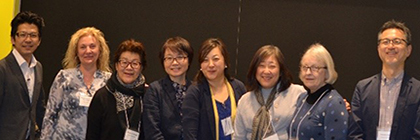A linguistics conference hosted by York University’s Department of Languages, Literatures & Linguistics (DLLL) in the Faculty of Liberal Arts & Professional Studies (LA&PS), examined the language of Japanese food May 4 and 5 at York’s Keele Campus.
The Conference on the Language of Japanese Food 2018 (CLJF2018) was the first attempt to break away from existing “language of food” presentations that tend to centre around Indo-European and Western food.
Since the 2014 publication of The language of food: a linguist reads the menus by Stanford University Professor Dan Jurafsky (New York/London: W.W. Norton & Company), “the language of food” has been recognized as an important area of study in linguistics.
CLJF2018 brought together emerging and established researchers with different specializations (including lexical semanticists, generative syntacticians, phoneticians, morphologists, discourse and conversation analysts), from 12 institutions in the U.S., Canada, Malaysia and Japan.

Some of the attendees and presenters (from left): Gakuji Kumagai (Meikai University) who presented “The sound-symbolic effect of consonant voicing on the naming of snacks in Japanese: An experimental study”; Roberta Iannacito-Provenzano (Chair of DLLL, LA&PS); Masako Hiraga (Rikkyo University), one of the keynote speakers; Toshiko Yamaguchi (University of Malaya) who presented “EAT: when embodiment reaches its limit”; Sayaka Abe (Middlebury College) who presented “Food and force: A conceptual analysis of Japanese online columns”; Keiko Murasugi (Nanzan University), who presented “Innovative compounds in Japanese food descriptions and beyond” co-authored with Kimi Akita (Nagoya University)”; Ann Wehmeyer (University of Florida) who presented “The use of mimetics in cooking blogs: Not just a matter of texture and taste”; and Takashi Suzuki (Seisen University), who presented “Evaluation of Japanese food in Japanese print and internet media: Healthy self-confidence?”
The conference opened with a welcome by DLLL Chair Roberta Iannacito-Provenzano, and continued with four themed sessions: (a) Conversation, discourse and gastronomic experiences; (b) Lexical semantics, loan and beyond; (c) Naming, branding and iconicity, and (d) Mimetics in food descriptions.
Sessions featured 10 paper presentations and three keynote lectures by researchers regarded as pioneers in applying linguistic concepts and methods to an analysis of Japanese food discourse and description, including: “Language and Japanese food in conversational interaction” by Professor Polly Szatrowski, University of Minnesota; “The Language of Food in Japanese through the Linguistic Lens” by Professor Natsuko Tsujimura, Indiana University; and “What’s in a name?: A case of Japanese sake” by Professor Masako Hiraga, Rikkyo University, Tokyo.
“The Conference on the Language of Japanese Food, which brought together international scholars, was extremely timely and the thought-provoking papers allowed us to make deep connections across languages on this interesting topic,” said Iannacito-Provenzano. “DLLL is very happy to support initiatives that promote research that has an impact at local and international levels and studies on language and communities through the food lens provide this opportunity.”
Kiyoko Toratani, the local organizer of CLJF2018 (Japanese section of DLLL, LA&PS), said the conference was a great success, according to the results of the post-conference questionnaire filled out by participants.
“The conference provided an excellent opportunity to foster intellectual interactions among researchers with different theoretical and methodological background,” said Toratani. “It was inspiring to witness not only that food-related mediums we see on a daily basis such as menus, recipes, food blogs, and food packaging are attested to serve as a rich source of linguistic information that is yet to be studied, but also that the language of the Japanese food can be approached from a variety of perspectives including a theoretically-newer standpoint, such as cognitive linguistics, without being confined to the traditional divisions of semantics, morphology, syntax, discourse analysis and so forth.”
CLJF2018 was co-organized by Mitsuaki Shimojo (University at Buffalo, The State University of New York), and assisted by Ahrong Lee (Korean section of DLLL, LA&PS).
The conference was supported by DLLL (LA&PS), York Centre for Asian Research, Office of the Dean (LA&PS), and the Japan Foundation.
Story submitted by Kiyoko Toratani


